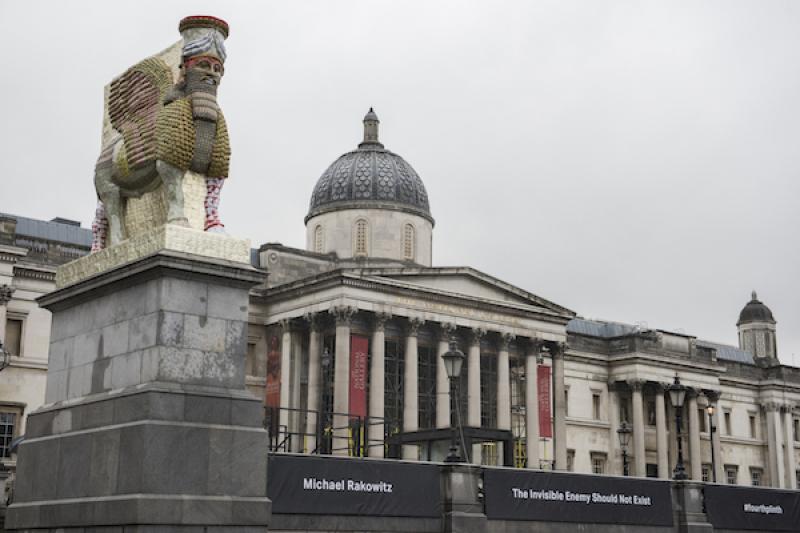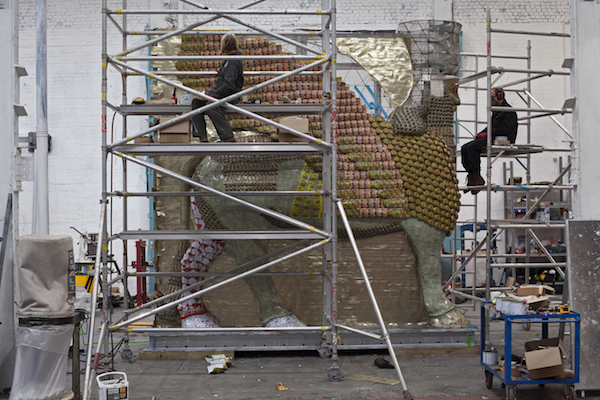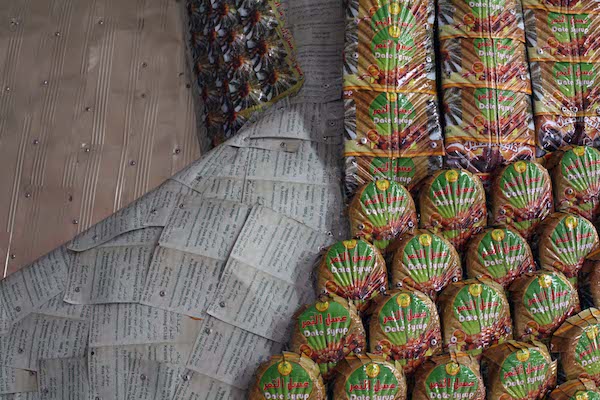Michael Rakowitz: The Invisible Enemy Should Not Exist, Fourth Plinth review - London's new guardian | reviews, news & interviews
Michael Rakowitz: The Invisible Enemy Should Not Exist, Fourth Plinth review - London's new guardian
Michael Rakowitz: The Invisible Enemy Should Not Exist, Fourth Plinth review - London's new guardian
Mythical Assyrian guardian deity occupies square commemorating battle

Fifteen years ago on a cold grey Saturday in mid-February, Trafalgar Square was filled with people marching to Hyde Park in opposition to the proposed invasion of Iraq. A million people gathered in London. Three times that number turned out in Rome.
Our present moment is deeply marked by those events and the 12th artwork to occupy the Fourth Plinth, The Invisible Enemy Should Not Exist, is a direct result of that tumultuous time. In the looting that followed the invasion, thousands of artefacts were stolen from archaeological sites and museums around the country including the National Museum of Iraq. In response, in 2007 American-Iraqi artist Michael Rakowitz began a project to reconstruct 7,000 of the missing artefacts from recycled Iraqi food packaging and newspapers, creating “ghosts” of the original works from throwaway items used every day in Iraqi households which provide “moments of cultural visibility” in America. The sculpture that was unveiled on Wednesday is a part of the same project but has a slightly different genesis. It is a reconstruction of the stone Lamassu, a mythological part-man, part-bull, part-eagle guardian that stood at the entrance to the Nergal Gate of the ancient Mesopotamian city of Nineveh, close to modern day Mosul. Until 2015 it was housed in the Mosul Museum but after Islamic State overran the city it was defaced with a pneumatic drill and destroyed along with hundreds of other artefacts which didn’t adhere to its extreme version of Islam. While IS’s destruction of these cultural treasures was in part religious fanaticisim, along with the looting that followed the 2003 invasion it shared an economic impulse. Illicit trade in antiquities has generated hundreds of millions of dollars for Islamic State’s coffers and by destroying some artefacts for publicity purposes and threatening the remaining ones, IS managed to buttress its religious credibility, while simultaneously restricting supply and leveraging prices to their financial advantage. Ironically, when Mosul was recaptured by Iraqi forces last year the museum was found to have been used as a tax department.
The sculpture that was unveiled on Wednesday is a part of the same project but has a slightly different genesis. It is a reconstruction of the stone Lamassu, a mythological part-man, part-bull, part-eagle guardian that stood at the entrance to the Nergal Gate of the ancient Mesopotamian city of Nineveh, close to modern day Mosul. Until 2015 it was housed in the Mosul Museum but after Islamic State overran the city it was defaced with a pneumatic drill and destroyed along with hundreds of other artefacts which didn’t adhere to its extreme version of Islam. While IS’s destruction of these cultural treasures was in part religious fanaticisim, along with the looting that followed the 2003 invasion it shared an economic impulse. Illicit trade in antiquities has generated hundreds of millions of dollars for Islamic State’s coffers and by destroying some artefacts for publicity purposes and threatening the remaining ones, IS managed to buttress its religious credibility, while simultaneously restricting supply and leveraging prices to their financial advantage. Ironically, when Mosul was recaptured by Iraqi forces last year the museum was found to have been used as a tax department.
Buyers of these blood antiquities are of all nationalities, but a large concentration have been sold in London along the slips of road by the British Museum — where a pair of lion-footed Lamassu from the Ishtar gate of the Assyrian city of Nimrud are housed. In reference to the millions of Iraqis displaced within their own country and spread out across the world, the Trafalgar Square Lamassu faces south-east towards its past home of Nineveh. This is also down Whitehall along which protesters thronged a decade and a half ago, but what proportion of the estimated 20 million people who will see this sculpture would be able to place Mosul on a map? That said, its 1:1 scale matches the Fourth Plinth footprint precisely and is a fit reminder of how entwined the two countries are in each other’s histories.
In the years since the invasion of Iraq and the wave of popular uprisings since 2011 there’s been a distinct rise in appreciation of Middle Eastern culture – and if the art, food and music are becoming cool and lucrative, as the economic opportunities open up, Rakowitz’s injunction that “We must enjoy our culture and never ever take it for granted,” becomes easier to stick to. More immediately, the sculpture’s glorious ostentation renders hundreds of years of Iraqi culture unavoidably and excitably visible while also serving as a stark memorial for all the lives which, unlike many of the destroyed artefacts, simply "cannot be reconstructed".
In the days since its unveiling, London has been decidedly dour but just imagine how brighly its hammered metal message will shine in the sun.
- The Invisible Enemy Should Not Exist is on display on the Fourth Plinth in Trafalgar Square until March 2020
- Read more visual arts reviews on theartsdesk
rating
Share this article
The future of Arts Journalism
You can stop theartsdesk.com closing!
We urgently need financing to survive. Our fundraising drive has thus far raised £49,000 but we need to reach £100,000 or we will be forced to close. Please contribute here: https://gofund.me/c3f6033d
And if you can forward this information to anyone who might assist, we’d be grateful.

Subscribe to theartsdesk.com
Thank you for continuing to read our work on theartsdesk.com. For unlimited access to every article in its entirety, including our archive of more than 15,000 pieces, we're asking for £5 per month or £40 per year. We feel it's a very good deal, and hope you do too.
To take a subscription now simply click here.
And if you're looking for that extra gift for a friend or family member, why not treat them to a theartsdesk.com gift subscription?
more Visual arts
 'We are bowled over!' Thank you for your messages of love and support
Much-appreciated words of commendation from readers and the cultural community
'We are bowled over!' Thank you for your messages of love and support
Much-appreciated words of commendation from readers and the cultural community
 Folkestone Triennial 2025 - landscape, seascape, art lovers' escape
Locally rooted festival brings home many but not all global concerns
Folkestone Triennial 2025 - landscape, seascape, art lovers' escape
Locally rooted festival brings home many but not all global concerns
 Sir Brian Clarke (1953-2025) - a personal tribute
Remembering an artist with a gift for the transcendent
Sir Brian Clarke (1953-2025) - a personal tribute
Remembering an artist with a gift for the transcendent
 Emily Kam Kngwarray, Tate Modern review - glimpses of another world
Pictures that are an affirmation of belonging
Emily Kam Kngwarray, Tate Modern review - glimpses of another world
Pictures that are an affirmation of belonging
 Kiefer / Van Gogh, Royal Academy review - a pairing of opposites
Small scale intensity meets large scale melodrama
Kiefer / Van Gogh, Royal Academy review - a pairing of opposites
Small scale intensity meets large scale melodrama
 Jenny Saville: The Anatomy of Painting, National Portrait Gallery review - a protégé losing her way
A brilliant painter in search of a worthwhile subject
Jenny Saville: The Anatomy of Painting, National Portrait Gallery review - a protégé losing her way
A brilliant painter in search of a worthwhile subject
 Abstract Erotic, Courtauld Gallery review - sculpture that is sensuous, funny and subversive
Testing the boundaries of good taste, and winning
Abstract Erotic, Courtauld Gallery review - sculpture that is sensuous, funny and subversive
Testing the boundaries of good taste, and winning
 Edward Burra, Tate Britain review - watercolour made mainstream
Social satire with a nasty bite
Edward Burra, Tate Britain review - watercolour made mainstream
Social satire with a nasty bite
 Ithell Colquhoun, Tate Britain review - revelations of a weird and wonderful world
Emanations from the unconscious
Ithell Colquhoun, Tate Britain review - revelations of a weird and wonderful world
Emanations from the unconscious
 Rachel Jones: Gated Canyons, Dulwich Picture Gallery review - teeth with a real bite
Mouths have never looked so good
Rachel Jones: Gated Canyons, Dulwich Picture Gallery review - teeth with a real bite
Mouths have never looked so good
 Yoshitomo Nara, Hayward Gallery review - sickeningly cute kids
How to make millions out of kitsch
Yoshitomo Nara, Hayward Gallery review - sickeningly cute kids
How to make millions out of kitsch
 Hamad Butt: Apprehensions, Whitechapel Gallery review - cool, calm and potentially lethal
The YBA who didn’t have time to become a household name
Hamad Butt: Apprehensions, Whitechapel Gallery review - cool, calm and potentially lethal
The YBA who didn’t have time to become a household name

Add comment